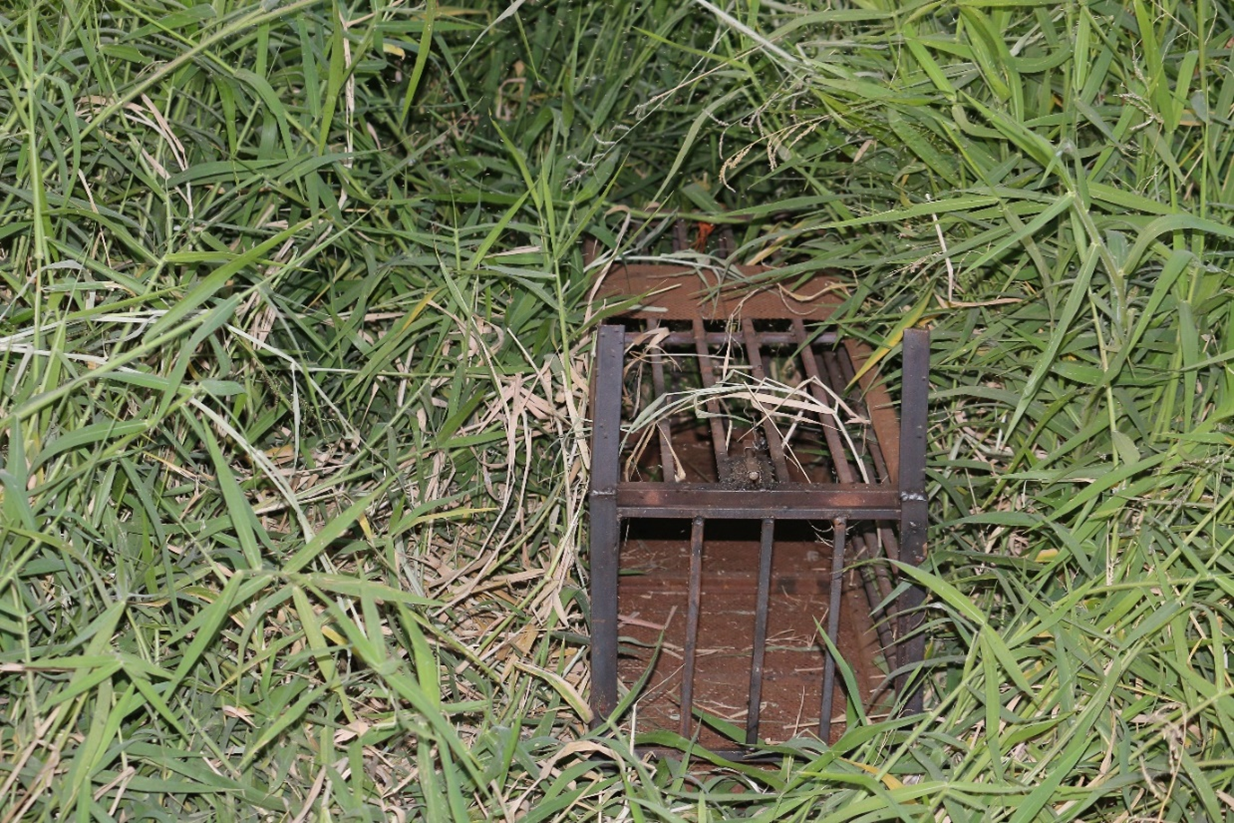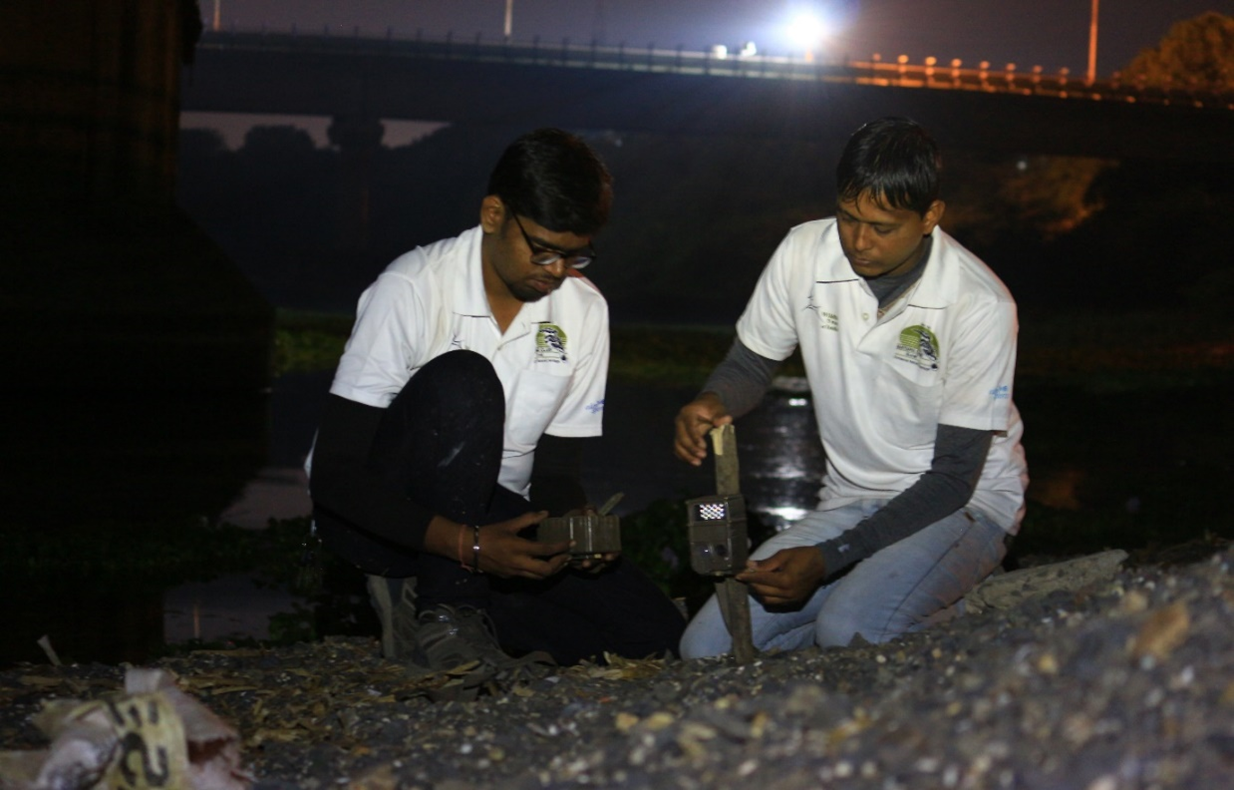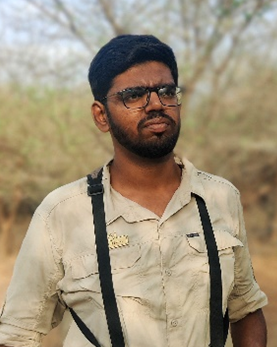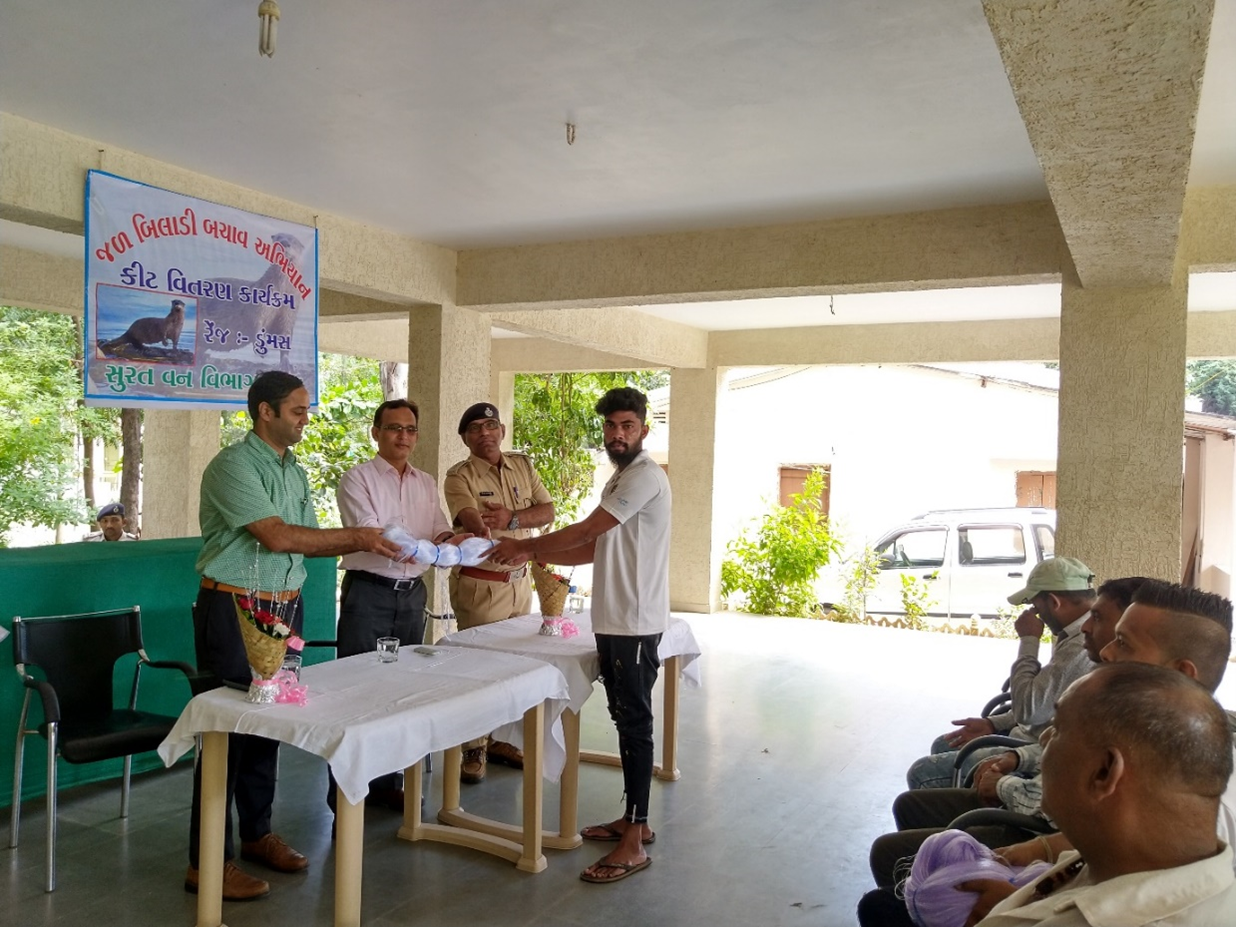IUCN/SSC Otter Specialist Group Bulletin

©IUCN/SCC Otter Specialist Group
Volume 40 Issue 2 (April 2023)
Citation: Trivedi, K. and Variya, M. (2023). Interactions between Fishermen and Smooth-Coated Otters (Lutrogale perspicillata) in the Tapti river of Surat District: A Case Study on Conflict Mitigation. IUCN Otter Spec. Group Bull. 40 (2): 64 - 71
Interactions between Fishermen and Smooth-Coated Otters (Lutrogale perspicillata) in the Tapti river of Surat District: A Case Study on Conflict Mitigation
Krunal Trivedi* and Mayur Variya
1Nature Club Surat, 81, Sarjan Society, Parle Point, Surat, Gujarat, India
*Corresponding Author Email: krunal.trivedi.7567@gmail.com
Received 23rd April 2022, accepted 10th November 2022
Abstract: The Smooth-coated otter (Lutrogale perspicillata) is a vulnerable mammal found in South Asia and Southeast Asia. The Tapti River, flowing within Gujarat, is home to many fishes, reptiles, birds, and thousands of other creatures. Smooth-coated Otters living in the Tapti River is threatened by a number of factors, including conflict with fishermen. As fishering communities depend on the Tapti River for their livelihood, this has led to trapping, poisoning, and hunting of otters as they have been causing economic loss by preying on fish catches and damaging the nets. To understand the nature and extent of this negative interaction, and the impact that it has on local fishermen, Nature Club Surat, Wildlife Trust of India and Gujarat Forest Department conducted interviews and surveys. As a part of the pilot project started by NCS and WTI to create a compensation policy, fishermen were reimbursed for their economical loss. Sensitization programs for otters among the fishering community, and compensating their losses caused by otter, is having a positive effecton the conservation of the species..
Keywords: Fishermen-otter interaction, Smooth-coated otter, Compensation policy, India.
INTRODUCTION
Human-animal interactions and conflict is well documented across the world. A high conflict ratio can be observed if the humans and animals compete for the same resources (Freitas et al., 2007). In India, fisheries and aquaculture are important sectors of the food industry, and increasing growth in the sector is creating conflict with animals and birds that are dependent on fish. Among three species of otters found in India (Menon, 2014), the Smooth-coated otter (Lutrogale perspicillata) is found in Gujarat (Suthar et al., 2017). Trivedi and Joshi (2018) reported conflict between fish farmers and otters in Surat. Similar kinds of fishermen-otter conflict have been reported for African clawless otters (Ergete at al., 2018), Giant otters (Gómez and Jorgenson, 1999; Roopsind, 2002; Carrera, 2003; Rosas et al., 2003; Gómez, 2004; Zucco, 2004; Carrera-Ubidia, 2007; Recharte et al., 2008; Rosas-Ribeiro et al., 2011), Spotted-necked otters (Akpona et al., 2015) and Eurasian otters (Václavíková et al., 2011).
The present study reports the negative interaction between Smooth-coated otter (Lutrogale perspicillata) and fishermen in the Tapti river of Surat, and strategies used for mitigation. Riverine fishermen prefer gillnet fishing over many other techniques (Petrere, 1978; Batista et al., 1998; Crampton et al., 2004) as it provides them time to do other activities after setting gillnets in the water (Freitas and Rivas, 2006).
In Surat, fishermen leave the gillnets overnight in the Tapti river and check the nets every morning for the catch. In last few years, otters have been reported preying on the netted fish from gillnets. While preying on netted fishes, otters cause extensive damage to the nets (Fig. 1). The nets are torn apart and destroyed completely by otters in 4-8 weeks. Previously, Giant otter and African-clawless otter have been reported to feed on netted fishes and damage gillnets (Ergete et al., 2018; Rosas-Ribeiro et al., 2011). Due to the economic losses caused by damaged nets, fishermen are documented using various ways to eliminate otters from the fishing areas. During this study, we found poisoned fishes, a cage trap, and evidence of intentional habitat destruction done by fishermen to eliminate the otter population. In India, Smooth-coated otters are protected under schedule II of the Wild Life (Protection) Act, 1972. Any attempt to harm or kill is a punishable offense under Section 9(1) of WPA 1972. The species is listed in appendix I of CITES (CITES, 2019) and stated as vulnerable in the IUCN Red List (de Silva et al., 2015).
MATERIALS AND METHODS
Data was collected between 2015 and 2019 from four locations in Surat city. Negative interactions with otters were investigated by interviewing and assisting fishermen in their daily fishing activities. Interviews with fishermen gave a summary of the current scenario. Fishermen explained all the measures taken to avoid otters damaging their nets. Some of the ways used to eliminate otters from their fishing ground were harmful, such as trapping (Fig. 2) and poisoning (Fig. 3). All the interviews were oral and informal. A team of volunteers was formed alongside fishermen, and surveys were done on boats to cover otherwise unapproachable land around the river. A camera trapping exercise was conducted from November 2018 to February 2019 to confirm the presence of otters at the conflict sites (Fig. 4). Four infrared camera traps of Cuddeback X-change IR model were used for the study.



RESULTS
In the initial phase of the project, a preliminary survey was conducted in conflict-affected areas to understand the current scenario. The interactions/informal interviews (n=36) with the fishermen provided insightful information about otter distribution in the study area and the damage caused by them. Many fishermen (n=26) reported nets being damaged by otters during their everyday fishing activity. Some nets were partially torn while some were ripped to shreds and left unusable. As well as economic losses due to torn nets, fishermen also faced catch loss, where fish were preyed on by otters. Two otter bite cases were also reported during the survey from the Rander area of Surat. Similar otter bite cases are also reported in other parts of India. (Govind and Jayson, 2018; Thakor, 2015). Otter presence was confirmed on the basis of camera trap photos, direct sightings and indirect signs.
DISCUSSION
The present study provides insights of fishermen-otter interaction in Surat district. The study also provided baseline data for otter conflict, otter ecology, potential threats, and conservation status. At the beginning of the study, all the fishermen considered otters to be a potential threat to their livelihood. The fact that Smooth-coated otters’ predatory behavior is quite conspicuous facilitates mental construction of a relationship between these animals and any problem related to fish depletion. Thus, the negative interactions between fishermen and otters were noteworthy and need to be addressed.
After surveying the human-otter conflict situation, the project focused on changing the perception of fishermen about otters and involving them in otter conservation. Sensitization programs were conducted with the fishing community to make them aware about the importance of otters. Later on, a few of them were trained to use camera traps for documenting otters. This newly formed group of fishermen was named “Team Otter Watch”.
A workshop on Human-animal conflict was organized by Nature Club Surat, Wildlife Trust of India, and the forest department. A session on the importance of otters in Surat and their interactions with fishermen was presented during the workshop. On the occasion of World Wildlife Day 2019, fishing nets and appreciation certificates were distributed to the fishermen (Fig. 5) who were helping us in carrying out activities such as camera trapping, locating otters, boat surveys, interviews, short film documentation, and many other activities for the conservation of otters in Tapti River. The nets were distributed under ex gratia support from Nature Club Surat, Wildlife Trust of India, and the Gujarat Forest Department as compensation for nets damaged by otters. Some fishermen joined the seasonal job of removing water hyacinth from the Tapti River under Surat Municipal Corporation, which helps in keeping the riverine habitat healthy.
These initiatives acted as a mediator for all the stakeholders and everyone played a vital role in the species conservation. The forest department has taken the issue forward to the state government for starting/granting a compensation policy. Other identified threats such as habitat destruction, sand mining, poaching, etc are needed to be addressed as well. Negative interaction between fish farms or aquaculture farm owners and otters is a serious concern and a proper study needs to be done to assess the threat level. In European countries, compensation for economic loss, and use of electrical fencing around small lakes and ponds, is used most frequently for mitigating/avoiding predation of fishs (Leblanc, 2003; Jay et al., 2008). The activities done under this project will continue in the future and efforts shall be made to develop a proper conservation strategy to save this elusive and important animal species.
CONCLUSION
In a broader sense, the objective of this study was to establish an example for species conservation and to reduce human-animal conflict in a human-dominated habitat. It is critical that conservation education be linked to the livelihoods of local people in order to ensure local support for better management of human-wildlife conflict. A well-planned and long-term comprehensive communication strategy should be designed to obtain effective results. The duties of the administration, the media, the general public, and decision-makers should all be considered and tailored during the conflict situation.
Acknowledgements: We would like to express our gratitude to Dr. NVK Ashraf, Ms. Snehaa Sundaram, Mr. Debobroto Sircar from Wildlife Trust of India for their support through Rapid Action Project. We would like to thank Mr. Snehal Patel, Mr. Ashish Vakil from Nature Club Surat, Mr. Puneet Nayyar from Gujarat Forest Department, and Vidya Athreya from Wildlife Conservation Society for their guidance in the project. We would like to thank Nature Club Surat, Surat Forest Department for Surat Municipal Corporation for their continuous support. We would also like to thank Chitra Patel, Mukesh Vasava, Raj Jariwala, Rakesh Patel, Shailesh Tank, Pratik Patel, and Shaival Patel for assisting in the fieldwork.
REFERENCES
Akpona, A.H., Djagoun, C.A.M.S., Harrington, L.A., Kabré, A.T., Mensah, G.A., Sinsin, B. (2015). Conflict between spotted-necked otters and fishermen in Hlan River, Benin. Journal for Nature Conservation, 27: 63-71.
Batista, V.S., Inhamuns, A.J., Freitas, C.E.C., Freire-Brasil, D. (1998). Characterization of the fishery in riverine communities in the Low-Solimões/High-Amazon region. Fish Manage Ecol. 5: 101-117.
Carrera, P. (2003). Solapamiento de nicho entre el hombre y la nutria gigante (Pteronura brasiliensis, Carnivora: Mustelidae) en la cuenca baja del Río Yasuní, Parque Nacional Yasuní, Amazonía Ecuatoriana. Undergraduate Monograph, 60 pp. Pontificia Universidad Católica Del Equador, Quito.
Carrera-Ubidia, P.M. (2007). Giant otters (Pteronura brasiliensis) and humans in the lower Yasuní Basin, Ecuador: spacio-temporal activity patterns and their relevance for conservation. MSc dissertation, 139 pp. Oregon State University, Corvallis.
CITES (2019). Appendices I, II and II. CONVENTION ON INTERNATIONAL TRADE IN ENDANGERED SPECIES OF WILD FAUNA AND FLORA. https://cites.org/eng/disc/text.php
Crampton, W.G.B., Castello, L., Viana J.P. (2004). Fisheries in the Amazon Varzea – historical trends, current status and factors affecting sustainability. In: Silvius, K.M., Bodmer, R.E., V. Fragoso, J.M.V. (eds.). People in nature: wildlife conservation in South and Central America, pp. 76–98. Columbia University Press, New York.
de Silva, P., Khan, W.A., Kanchanasaka, B., Reza Lubis, I., Feeroz, M.M., Al-Sheikhly, O.F. (2015). Lutrogale perspicillata. The IUCN Red List of Threatened Species 2015: e.T12427A21934884. Downloaded on 27 June 2020. https://dx.doi.org/10.2305/IUCN.UK.2021-3.RLTS.T12427A164579961.en
Ergete E.A., Hailemariam T.W., Balakrishnan M., Serfass T.L. (2018). Fishermen knowledge and conflict with African clawless otters in and around Lake Tana, Ethiopia. African Journal of Ecology. 56: 1-5
Freitas, C.E.C., Rivas, A.A.F. (2006). A pesca e os recursos pesqueiros na Amazônia Ocidental. Ciência e Cultura. 52: 30-32.
Freitas, D., Gomes J., Luis, T.S., Madruga, L., Marques, C, Baptista G, Rosalino L. M ., Antunes P. Santos R., Santos-Reis M. (2007). Otters and fish farms in the Sado estuary: ecological and socio-economic basis of a conflict. Hydrobiologia. 587: 51-62.
Gómez, J.R., Jorgenson, J.P. (1999). An overview of the giant otter fisherman problem in the Orinoco basin of Colombia. IUCN Otter Spec. Group Bull. 16: 1-6. https://www.iucnosgbull.org/Volume16/Gomez_Jorgenson_1999.html
Gómez, D.M.V. (2004). Valoración biologica e cultural de la nutria gigante (Pteronura brasiliensis), em el área de influencia de Puerto Carreño, Vichada, Colombia (Rios Orinoco, Bita, Caños Juriepe y Negro). Undergraduate Monograph, 104 pp. Pontificia Universidad Javeriana, Facultad de Estudios Ambientales y Rurales, Bogotá, Colombia.
Govind S.K., Jayson E.A. (2018). Attack of otter on humans in Thrissur, Kerala, India. IUCN Otter Spec. Group Bull. 35: 57-61. https://www.iucnosgbull.org/Volume35/Govind_Jayson_2018.html
Jay, S., Lane, M., O’Hara, K., Precey, P., Scholey, G. (2008). Otters and Still Water Fisheries. The Widlife Trusts, 26-27.
Leblanc, F. (2003). Protecting fish farms from predation by the Eurasian otter (Lutra lutra) in the limousin region of central France: First results. IUCN Otter Spec. Group Bull. 20: 45-48. https://www.iucnosgbull.org/Volume20/Leblanc_2003.html
Menon, V. (2014). Indian mammals: a field guide. Hachette India Book Publishing India Pvt. Ltd. 300-303.
Petrere. Jr, M. (1978). Pesca e esforço de pesca no Estado do Amazonas – Locais, aparelhos de captura e estatística de desembarque. Acta Amazonica. 8: 5-54.
Recharte, M., Bowler, M., Bodmer, R. (2008). Potential conflict between fishermen and giant otter (Pteronura brasiliensis) populations by fishermen in response to declining stocks of arowana fish (Osteoglossum bicirrhosum) in northeastern Peru. IUCN Otter Spec. Group Bull. 25: 89-93. https://www.iucnosgbull.org/Volume25/Recharte_et_al_2008.html
Roopsind, I. (2002). Fish consumption by giant otters (Pteronura brasiliensis) in the North Rupununi Wetlands. Undergraduate Monograph, 17 pp. University of Guyana, Guyana.
Rosas, F.C.W., Sousa-Lima, R.S., Silva, V.M.F. (2003). Avaliação preliminar dos mamíferos do baixo rio Purus. In: de Deus, C.P., da Silveira, R., Py-Daniel, L.H.R. (eds.). Piagaçu-Purus: Bases científicas para a criação de uma reserva de desenvolvimento sustentável. IDSM, Manaus, Brazil.
Rosas-Ribeiro, P.F., Rosas, F.C.W., Zuanon, J. (2011). Conflict between Fishermen and Giant Otters Pteronura brasiliensis in Western Brazilian Amazon. BIOTROPICA 44(3): 437-444.
Suthar, A.R., Rathod, J.Y., Patel, I.B., Gavali, D.J., Lakhmapurkar, J, (2017). Historical and current distribution of smooth-coated otter Lutrogale perspicillata in Gujarat, India. IUCN Otter Spec. Group Bull. 34(2): 95-103. https://www.iucnosgbull.org/Volume34/Suthar_et_al_2017.html
Thakor, P. (2015). Tena village wetland, Surat district, Gujarat, India. Jalaplavit. 6: 44-53.
Trivedi, K., Joshi, P, (2018). Photographic documentation and distribution of smooth-coated otter (Lutrogale perspicillata) (Geoffroy 1826) in Surat, Gujarat. IUCN Otter Spec. Group Bull. 35: 31-36. https://www.iucnosgbull.org/Volume35/Trivedi_Joshi_2018.html
Václavíková, M., Václavík, T., Kostkan, V. (2011). Otters vs. fishermen: Stakeholders’ perceptions of otter predation and damage compensation in the Czech Republic. J. Nature Cons. 19: 95-102.
Zucco, C. A. (2004). Diagnóstico preliminar do conflito potencial entre Pescadores e as populações de ariranhas (Pteronura brasiliensis) e jacarés- dopantanal (Caiman yacare) no Pantanal Matogrossense: contribuições para a gestão da fauna. Undergraduate Monograph, 120 pp. Universidade Federal de Santa Catarina, Florianópolis, Brazil.
Résumé: Interactions entre les Pêcheurs et la Loutre à Pelage Lisse (Lutrogale perspicillata) dans la Rivière Tapti du District de Surat : Une Étude de Cas sur les Mesures d’Accompagnement des Conflits
La loutre à pelage lisse (Lutrogale perspicillata) est un mammifère vulnérable que l’on trouve en Asie du Sud et du Sud-Est. La rivière Tapti, qui coule dans le Gujarat, abrite de nombreux poissons, reptiles, oiseaux et des milliers d’autres espèces. La loutre à pelage lisse qui vit dans la rivière Tapti est menacée par un certain nombre de facteurs, dont les conflits avec les pêcheurs. Comme les communautés de pêcheurs dépendent de la rivière Tapti pour leur subsistance, cela a conduit à la capture, l’empoisonnement et la chasse des loutres qui sont à l’origine de pertes économiques par prédation des prises de poisson et dégradation des filets. Afin de comprendre la nature et l’étendue de cette interaction négative, et l’impact qu'elle a sur les pêcheurs locaux, le Club Nature de Surat (CNS), le « Wildlife Trust of India » (WTI) et le Département des Forêts du Gujarat ont mené des entretiens et des enquêtes. Dans le cadre d’un projet pilote lancé par le CNS et le WTI en vue de lancer une politique d’indemnisation, les pêcheurs ont été remboursés de leur perte économique. Des programmes de sensibilisation de la communauté des pêcheurs aux loutres et la compensation des pertes causées par les loutres ont permis la préservation de l’espèce.
Revenez au dessus
Resumen: Interacciones entre los Pescadores y la Nutria Lisa (Lutrogale perspicillata) en el Río Tapti, Distrito de Surat: Un Estudio de Caso sobre la Mitigación de Conflictos
La nutria lisa (Lutrogale perspicillata) es un mamífero vulnerable que se encuentra en el Sur y Sudeste de Asia. El Río Tapti, que discurre por Gujarat, es hogar para muchos peces, reptiles, aves, y miles de otras criaturas. Las Nutrias Lisas que viven en el Río Tapti están amenazadas por un número de factores, incluyendo el conflicto con los pescadores. Como las comunidades de pescadores dependen del Río Tapti para su subsistencia, eso condujo a captura, envenenammiento, y caza de las Nutrias ya que éstas han venido causando pérdidas económicas, al depredar los peces capturados y dañar las redes. Para entender la naturaleza y magnitud de ésta interacción negativa, y el impacto que tienen sobre los pescadores locales, Nature Club Surat (NCS), el Wildlife Trust de India (WTI) y el Departamento Forestal de Gujarat condujeron entrevistas y relevamientos. Como parte de un proyecto piloto comenzado por NCS y WTI para comenzar una política de compensación, los pescadores fueron reembolsados por sus pérdidas económicas. Los programas de sensibilización entre la comunidad de pescadores, y la compensación por sus pérdidas económicas causadas por las nutrias, ayudaron a la conservación de la especie.
Vuelva a la tapa



